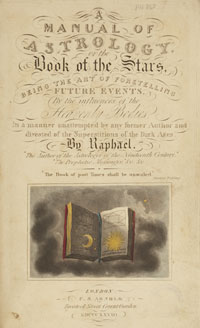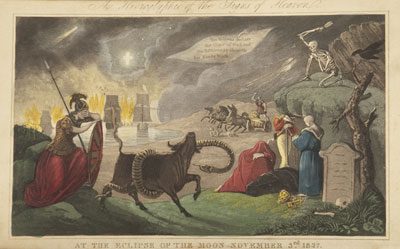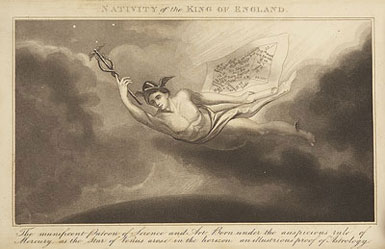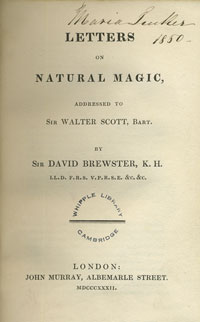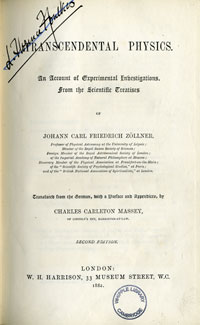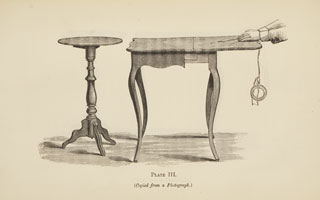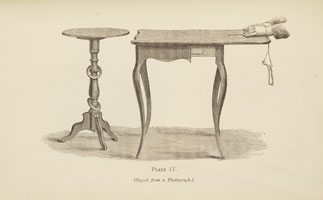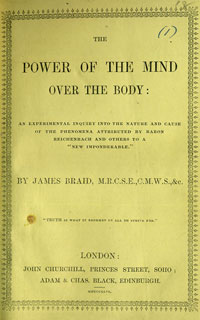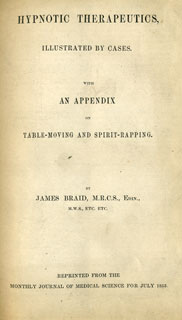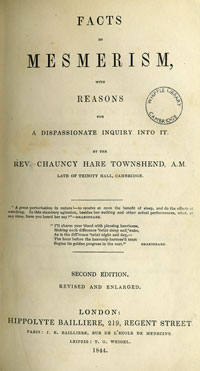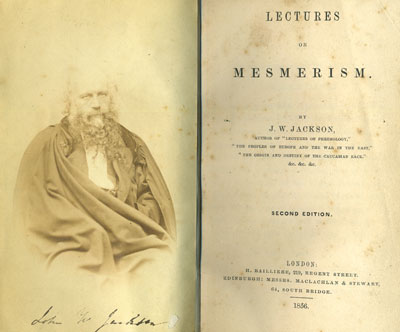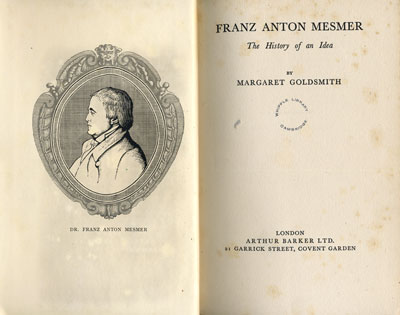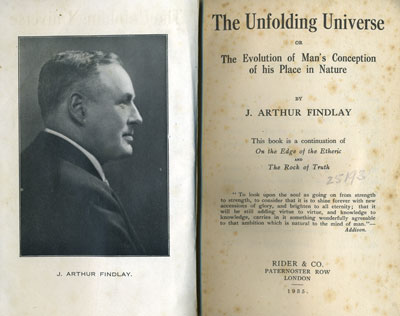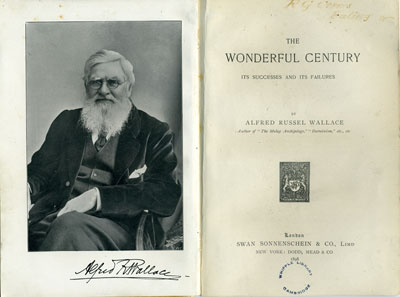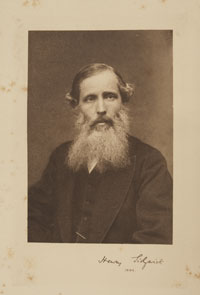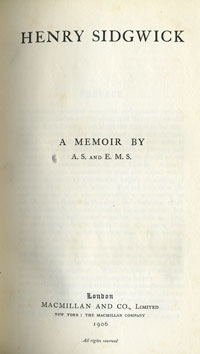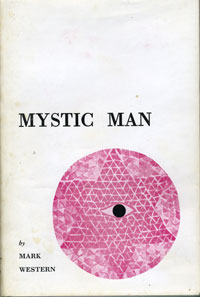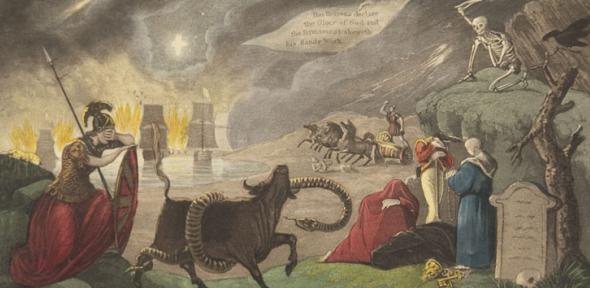
Mysterious phenomena have fascinated people throughout history, from the ancient use of astrology to the current curiosity in new age magic and ghost hunting. One question historians have tried to answer is why there was such an attraction to these supernatural beliefs and phenomena in the 19th century. Some consider the development of science as the tool to explain everything in nature posing a threat to traditional Christian beliefs as the cause. Investigations into spiritual mediumship and other related phenomena have been observed as an approach that some scientists used to combine science and religion. This display shows a number of books from the Whipple's collection that illustrates that even in the 'age of science' scientists and the general public had a keen interest in the unknown.
Raphael, A manual of astrology, or the, book of the stars: being the art of foretelling future events, by the influences of the heavenly bodies, in a manner unattempted by any former author and divested of the superstitions of the Dark Ages, 1828
This attractive book, dedicated to Sir Walter Scott, refers to astrology as a science and mentions '...that every problem is calculated merely by an arithmetical process, devoid of any thing resembling divination'. It gives the reader instruction on how to make horoscope charts and contains handwritten perpetual tables of the celestial houses. 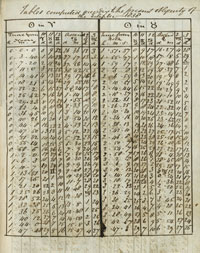
Sir David Brewster, Letters on natural magic: addressed to Sir Walter Scott, 1832
Brewster's book, written as a reply to Scott's Letters on Demonology and Witchcraft (1830), seeks to demonstrate that phenomena seen as magical and supernatural could actually be explained through scientific discoveries and inventions.
Johann Carl Friedrich Zollner, Transcendental physics: an account of experimental investigations from the scientific treatises of Johann Carl Friedrich Zollner, 1882
Johann Zollner (1834–1882), a Professor of Astrophysics at Leipzig, embarked on his study of spiritualism after becoming interested in the fourth dimension of space and meeting William Crookes in 1875 (to whom this book is dedicated). This book describes experiments he performed in 1877 with Henry Slade, an American medium. On the run from the authorities in England after being convicted of fraud, Slade convinced Zollner and his fellow séance participants (all respected German scientists) of his skills through the appearance of handwriting on slates, moving of objects and clairvoyance. 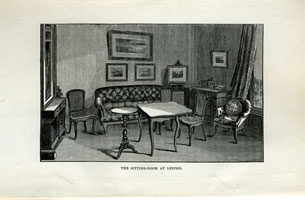 Zollner believed that these supernatural phenomena were caused by either Slade or spirits working in the fourth dimension. He backed up his claims through reference to work undertaken on geometrical axioms and the fourth dimension by Hermann von Helmholtz. Zollner's work caused the first major controversy in modern German occultism. Significantly, the issues it raised surrounding imagination and the fourth dimension attracted the attention of figures such as Henri Poincare and Ludwig Wittgenstein.
Zollner believed that these supernatural phenomena were caused by either Slade or spirits working in the fourth dimension. He backed up his claims through reference to work undertaken on geometrical axioms and the fourth dimension by Hermann von Helmholtz. Zollner's work caused the first major controversy in modern German occultism. Significantly, the issues it raised surrounding imagination and the fourth dimension attracted the attention of figures such as Henri Poincare and Ludwig Wittgenstein.
The two plates show the before and after photographs of one of Zollner's experiments demonstrating the movement of objects by unknown means.
James Braid, The power of the mind over the body, 1846 and Hypnotic therapeutics, illustrated by cases with an appendix on table-moving and spirit-rapping, 1853
James Braid began investigating mesmerism in 1841, finding that mesmerism trances were not caused by animal magnetism or a mesmeric fluid but by 'a state of physical relaxation accompanied and induced by mental concentration'. This allowed him to develop his theory of hypnotism which he stated had no occult influences. He developed the idea that phenomena connected with mesmerism, such as the movement of objects, was actually caused by the muscles of those taking part in the séance moving unconsciously.
Each of these volumes is from the Whipple Library's Foster Collection of 19th-century pamphlets on physiology. Both volumes comprise a selection of published pamphlets on hypnotism.
Rev. Chauncy Hare Townshend, Facts in mesmerism with reasons for a dispassionate inquiry into it, 1844
English poet and collector Chauncy Hare Townshend began to study mesmerism in the 1830s. This allowed a friendship to develop between himself and Charles Dickens who he met at the house of a mesmerist in 1840. This book describes mesmeric sleepwalking whereby patients are placed into trances and controlled by the mesmerist. People in mesmeric trance often showed paranormal abilities such as clairvoyance.
J.W. Jackson, Lectures on mesmerism, Mesmerism in connection with popular superstitions, Ecstatics of genius, The seer of Sinai, 1856–58
The first two items in this bound volume consider mesmerism from various angles: as a topic for philosophic experiment, a technique of improving a person health and its connections with the supernatural. Jackson claims that '...mesmerism is ancient magic and thaumaturgy rebirthed under the more appropriate aspect of modern science'.
Margaret Goldsmith, Franz Anton Mesmer: the history of an idea, 1934
This biography of Mesmer seeks to link his ideas and practices with modern psychotherapy. It traces the history of mesmeric techniques from ancient times, through Mesmer himself, the work on hypnotism by James Braid, and then even connecting it to the early work of Sigmund Freud.
J. Arthur Findlay, The unfolding universe; or, The evolution of man’s conception of his place in nature, 1935
J. Arthur Findlay (1883–1964) a prominent British Spiritualist, claimed that spiritualism is '...religion and science combined in one harmonious whole'. He believed that scientific investigation alone could not explain all natural phenomena: only through combining science with the etheric could the universe be fully explained.
Alfred Russel Wallace, The wonderful century, 1898
Alfred Russel Wallace, one of the great Victorian scientists, publicly embraced spiritualism in 1866. He wrote a number of works on spiritualism including 'A defence of modern spiritualism' (1874), and 'Modern spiritualism – are its phenomena in harmony with science?' (1885). In the Wonderful century Wallace describes what he sees as successes and failures of the 19th century. In the failure section he includes a chapter entitled 'The opposition to hypnotism and psychical research' in which he criticises those who refuse to see the facts about mesmerism even when experiments involving men of learning had produced convincing evidence.
A.S. Sidgwick, Henry Sidgwick: a memoir, 1906
Henry Sidgwick, philosopher and support of women's education, was involved in the founding of the Society of Psychical Research and became its first president in 1882.
This book contains a biography and extracts from his letters including his investigations in to mediums and spiritualism.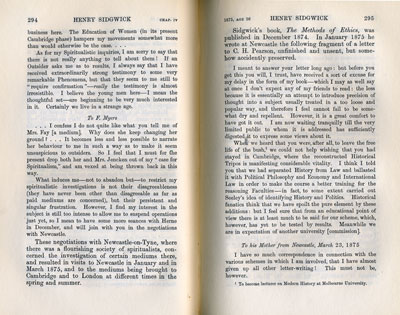
Mark Western, Mystic Man, 1966
This book provides a 14 week course on developing basic psychic skills and explains mysticism. It demonstrated the on-going interest in what is now referred to as the paranormal.
Dawn Moutrey

